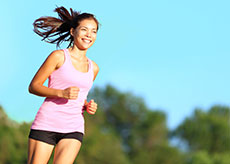
The environment in which you work out should be a factor in what you wear, and how you structure your activity.
When the temperatures start to soar, it’s important to remember that an outdoor exercise session will put extra stress on your body.
Jennifer Menk, Senior Director of Health & Wellbeing at YMCA of the North starts by saying, “Everyone has different thresholds. Are you already conditioned to workout out in the heat, or are you just starting a fitness program? There’s an extra need to tune in and listen to your body.”
What to wear
Jennifer encourages wearing lightweight, moisture-wicking and light-colored clothing. If you’re planning to enjoy an outdoor exercise class, you might also consider the type of activity you’ll be doing to determine what you wear.
How to structure your workout
There are four key factors to think about in warm weather:
- Scale—A workout in hot and humid weather is already going to be one of your hard workouts for the week, regardless of activity. Listening to your body might mean slowing down your pace or shortening the duration of your workout.
- Time—If you don’t want to head inside, consider doing your workout earlier in the day, before the heat.
- Location—You might also choose a location for your workout that is shaded, rather than in direct sunlight.
- Hydration—The more you sweat, the more you need to drink. Even when there’s lots of moisture in the air (humidity), your body is still losing fluid via sweating.
Signs you might be overdoing it in the heat
If you overdo it on an outdoor workout on a hot and humid day, your body will start overheating, and you might experience:
- Heat cramps—muscle spasms that usually happen during heavy exercise in a hot environment.
- Heat exhaustion—heavy sweating and a rapid pulse, often due to strenuous physical activity in a high-temperature and high humidity environment. If left untreated, it can lead to heatstroke.
- Heatstroke—a body temperature of 104 F or higher, due to physical exertion in high temperatures. Untreated heatstroke can damage the brain, heart, kidneys and muscles.
In addition to specific symptoms of the conditions above, Mayo Clinic suggests watching for these indications you might have a heat-related illness:
- Cool, moist skin with goose bumps while in the heat
- Feeling faint
- Dizziness
- Fatigue
- Nausea
- Headache
- Flushed skin
- Rapid breathing
How the heat can help
Although a hot day can add some extra considerations, there are some benefits to enjoy exercise in hot temperatures. Jennifer says, “In addition to burning more calories due to the added intensity of heat, higher temperatures can boost flexibility and range of motion.”
For example, hot yoga has been a popular choice for many because when your muscles are warm, you might experience greater flexibility. You also feel like you’re getting in a harder workout with the benefits of focusing on the mind-body connection.
Balance is important
If you choose to do an outdoor workout on a hot day—whether you’re hiking or swimming or running, Jennifer encourages you to cross-train in an indoor, climate-controlled environment, too. The Y has several locations that offer climate-controlled workouts for your indoor days.